Matterhorn
4478m mountain focus page 

Links: Summer
Matterhorn course or
Winter
Matterhorn ascent |

|
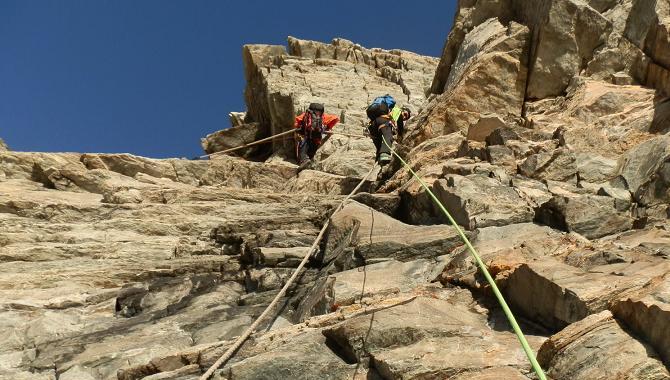 |
 |
| Welcome
to this mountain focus |
 |
 |
 |
 |
 |
We
are in the process of developing these mountain
focus pages for many of the key peaks that we offer
trips too, in order to help people prepare better
for their trips. We are always editing these pages,
so if you have any feedback about information we
should add to the page, please let us know. |
|
 |
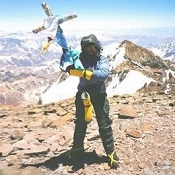 |
 |
This
page has largely been written by Jilly
from our Windermere
HQ, and it's here that most people
have their first contact with us, in person or on
the phone. We feel it's important that all our staff
are experts on the mountains we offer trips to,
so we are all involved in developing these focus
pages. |
|
 |
| History
and background |
 |
 |
 |
Possibly
the world's most recognisable and iconic peak that has
captured not only the imagination of alpinists - from
Whymper's first yet ultimately tragic ascent to the inconceivable
two hour solo ascent by Ueli Steck - but even non-climbers
cannot fail to be absorbed by its raw beauty. It has inspired
artists and poets, Disney and chocolate bars and every
year people flock to Zermatt to see this infamous mountain
for themselves.

Its steeped history mirrors the pyramidal shaped faces
all facing the points of the compass. A mountain that
was one of the last alpine mountains to be climbed commands
the area from Zermatt and is a sight to behold: its notorious,
seemingly razor sharp ridges are flanked by its northern
and eastern faces both in light and in shadow.

As Gaston Rebuffat wrote in his book "Men and the
Matterhorn" '.. the Matterhorn can resemble no
other peak - it is the model; similarly, no other peak
really resembles the Matterhorn, the mould has been broken,
there are not even any copies. The Matterhorn is unique.'

The Matterhorn stands alone straddling the border between
Italy and Switzerland and soaring to a height of 4478
metres. Some 200 million years ago it began its formation
and as time passed the rounded mountain of rock through
freeze / thaw erosion became the pyramid of ice and rock
as we know it today. |
 |
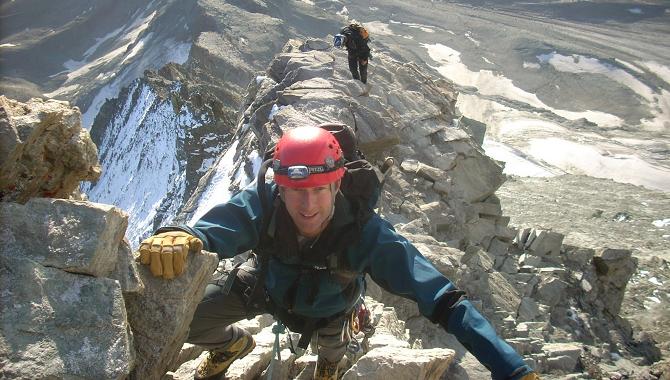 |
 |
| A
word of caution |
 |
 |
 |
Yet
despite the romanticism and the inevitable draw this majestic
peak has there have been over 500 deaths on the mountain
and it is important to realise this is a serious undertaking
and vital that you are competent on steep ground, comfortable
with exposure and are adept with ropework.

The Matterhorn is not for inexperienced ticklisters, it
requires commitment, significant rock climbing experience
and, as one of our clients rather candidly put it, "There's
no point beating about the proverbial bush when it comes
to the Matterhorn, I'm afraid. It's a serious chunk of
rock and you've got to be 100% up for it. Not one of the
easiest things I have ever done. But the Icicle team are
brill and if anyone can get you up there they will".

As we have mentioned before, there are three key points
to remember and to apply on any mountain;

1) The mountain will always be there. Do not push safety
boundaries on ascents as another can be made
2) The key to success is preparation in terms of information,
equipment, training, techniques and planning
3) Never set off considering rescue as an option (unless
there is an accident). Do not play poker with lives. |
 |
| The
key climbing seasons |
 |
 |
 |
Summer
- Our course dates start from early July to mid-September
which is typically known as the high season in the Alps
yet as with any mountain the weather can be unpredictable
- even more so with recent weather pattern changes. We
will always seek to find a suitable alternative should
weather and conditions require.

Winter - We also offer a winter ascent dependent on snow
conditions and we can only stress that this is only for
those with relevant experience, cast iron determination
and focus, skills and desire. See the itinerary here.
We normally can operate winter ascents any time between
December and April. Get in touch to discuss plans! |
 |
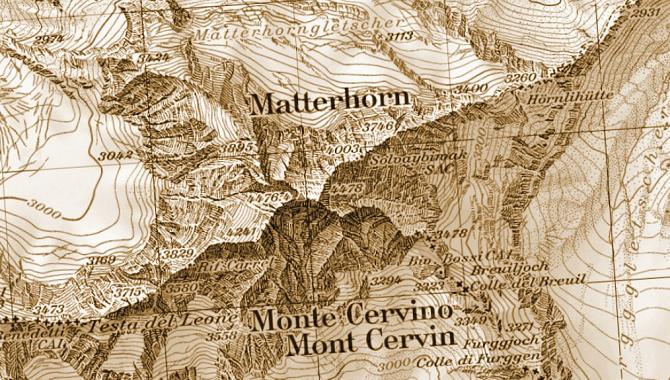 |
 |
| Routes
on the Matterhorn |
 |
 |
 |
With
its four ridges and four faces on the Matterhorn it is
an alpinist's dream with over 25 possible routes yet the
north-eastern Hornli Arete to the summit- while being
the most popular - is the safest in comparison and the
one we have chosen as the route of choice for the ascent
of this classic mountain. Here we review the two most
popular routes to ascend the Matterhorn.

Hornli Arete from Zermatt
On the map above, this is the ENE ridge, from Hornlihutte
to the summit at 4478m.

This
most popular and classic route is the Hornli ridge and
the route of the first ascent. It can be seen from Zermatt
and the angle of the route makes it even look like the
most logical one to climb as it leads its way to the summit.
There is a hut at 3260m which was built in the late 1800's
by the Swiss Alpine Club as the popularity and the draw
of the challenge grew. The hut is currently closed due
to renovation and extension works and will re-open in
2015 for the 150th anniversary celebrations of the first
ascent.

With an approximate 1200 metres of climbing from the Hornli
Hut to the summit, the actual ascent takes place over
two days. On the first day you drive to Tasch and then
take to the train to Zermatt and a cable car to Schwartzee.
From here there is a two hour hike up to the Hornli hut
(c. 700m of vertical climb) for an overnight stay which
helps with acclimatisation and is followed by an early
start to reach the summit and back the following day,
based on a 4am start to avoid the afternoon clouds and
storms that sweep regularly through. Once back at the
hut, you trek down to Schwartzee, and take the cable cars
back down to Zermatt.

Behind the hut there is a well definded track leading
to the base of the mountain. There's no gradual change
when you reach the foot of the mountain, to make you consider
when you stopped hiking and started climbing. It's abrupt,
and straight up! The lower section of the route follows
the right hand side of the East Face of the mountain,
below a series of towers to your right. When you go at
all off route here, you'll know about it, as there's a
huge increase in the amount of loose rock. Some climbers
lovingly refer to the Matterhorn as the 'world's biggest
cairn', and you'll see why. You gain height quickly, moving
together, usually all in the pre-dawn darkness in this
section.

As the dawn starts to increase the light over the Monte
Rosa behind you, at this time you should be close to the
Solvay emergency hut at 4003m. This old wooden refuge
is very basic inside, and the toilet can be detected by
your nose from quite a distance. Most climbers stop here
for a quick rest, before tackling the steep slabs above,
where there are fixed ropes to aid progress. On the upper
section of the mountains, you will notice more fixed equipment;
ropes, pig tails, metal spikes. These are all designed
to aid your progress, but when using them, spare a thought
for the first ascensionists, who had nothing but a rope
to protect them (or not)...

The shoulder looms above, and it is here that you make
the transition from the East Face to the left hand edge
of the North Face of the mountain, as you move up towards
the summit block. Here it is usual to put on crampons,
for the final 300m or so of the ascent. By now your head
torch won't be necessary, and you move up more sections
of fixed rope, and then steeper snowfields near the summit.
Ahead of you at the summit, you will see the statue and
also the cross. There are two summits, one in Switzerland,
and the other in Italy. The summit ridge between the two
is sharp, though usually there is a good crampon track
between the two.

After the summit photos, the descent is usually made down
the same way you came up, but great care needs to be taken,
as most people are not as good downclimbing as they are
in ascent. The normal timings for the ascent are up to
4 hours up, and a similar though often slightly longer
time for the descent back to the Hornli hut. On the descent
the crampons are often kept on as long as getting to the
Solvay hut.

Italian
(Lion) Ridge from Cervinia
On the map above, this is the WSW ridge, from Testa
del Leone to the summit at 4478m.

This
route is approached from Cervinia, and only has roughly
5% of the traffic of the Hornli Arete, so is a good choice
when you are trying to avoid the crowds. It also appeals
to those who wish to sleep high on the mountain in the
unguardianned Carrel hut at 3829m, thus shortening the
summit day significantly. This route on the Italian side
does have some disadvantages in that it is longer and
so more physically demanding, however the grade is almost
identical, though there is perhaps more exposure on this
route.

To ascend to the Carrel on the first day is a great hike,
that then turns into a scramble over loose ground up to
the base of the Lions Head (Testa del Leone). Here you
pass below the tower, and up a series of steeper steps
to reach the Carrel hut. This is basic, and perched on
the ridge, though is equipped with gas and cooking equipment,
so you don't have to carry anything extra apart from some
food. You spend the night in the hut here, and have an
early start the next morning, but not so early as that
in the Hornli Hut.

Above the hut the route is steep, and ascends a series
of fixed ropes to the top of a steep part of the ridge.
Here the gradient really stops, as you move along an almost
flat section of ridge, with huge exposure on each side.
At the far end of this ridge, the route steepens as you
move up onto the summit block and there are sections of
fixed ropes and even a ladder to aid progress in parts.
Ahead of you the summit cross comes into view, and crampons
are often used just for the final part of the climb.

The descent is made by the same route, so if you wanted
to travel a bit lighter, you could leave some items in
the Carrel hut in the morning, and collect them on your
way down the mountain. The descent is long, all the way
down to Cervina, but keep in your mind the record from
the summit down is just under one hour! It's unlikely
anyone will beat the record soon, as it's held by ski
mountaineering and trail running legend Kilian Jornet.
|
 |
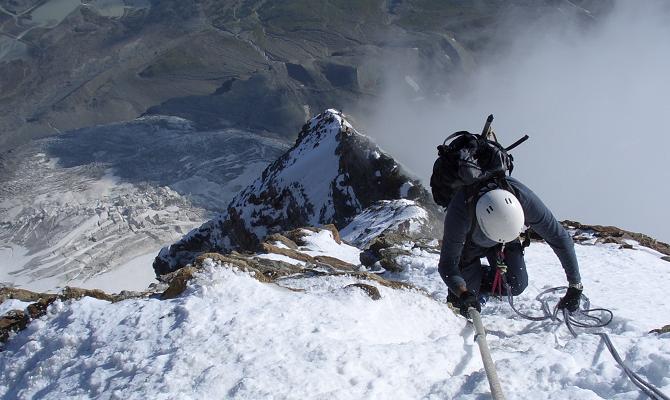 |
 |
| Guiding
ratio and grades |
 |
 |
 |
| The
guiding is always on a 1:1 ratio on the Matterhorn, which
helps you not only move at speed but gives you the best
possible chance for summit success. Despite the Hornli
Arete (also known as the Hornligrat) being the most popular
this does not mean it is by any means easy and anyone
thinking of signing up for this should be fully prepared
for sustained climbing (Alpine AD / Grade ll Ice / UK
Severe / US 5.9) on this long route. The Matterhorn is
not for inexperienced ticklisters, it requires commitment,
significant rock climbing experience. The grade alone
does not give a real impression of what the mountain is
really like. It's often described as a hard scramble,
or an easy rock climb, but nothing prepares you for the
amount of loose rock, and it's then that your experience
moving on steep broken mountain ground really kicks in.
The ascent is not too technical, but it often beats people
who are good climbers technically, but who aren't mountaineers.
The top section always requires crampons, so before any
course, you should have sufficient experience on steep
snow / ice too. |
 |
| Preparation
& Acclimatisation |
 |
 |
 |
An
ascent of the Matterhorn should not be underestimated,
and you should arrive for this course in good physical
condition as the climb will probably be the greatest physical
exertion of your life. Please don't ignore this issue...
We highly recommend that you read our training page (click
here) for details
on how to prepare. If
you are worried about acclimatisation, which is a real
concern for anyone attempting the Matterhorn, we highly
recommend that you book on an Acclimatisation
Weekend before
your course.

As
mentioned previously we require our clients to have specific
experience, skills and fitness before attempting the Matterhorn.
While not the most technical course we offer it is important
to be able to move quickly and adeptly up and over rock.
Indoor climbing while great for building up strength and
balance is not a substitute for rock so head to the Lakes
or North Wales: a couple of days getting used to uneven
terrain and gritty rock is a perfect way to improve your
skills never mind escaping those sweaty gyms and having
a douse of fresh air to invigorate your training.
Those that have not had much experience with crampons
could still attempt the Matterhorn if they have appropriate
rock climbing experience as it is only the final summit
block that usually demands crampons. We also expect you
to have the required levels of fitness for such a demanding
route not only for bettering your chances of summit success
but also for your own safety and well-being. Please follow
our training plans and, once you think you've reached
the physical peak required train even harder! |
 |
|
|
FREE
Podcast: Climbing the Matterhorn...  view
website course page
view
website course page
If you've ever wondered what it is like to
attempt the Matterhorn, the skills required,
and the suggested training for this peak,
then this podcast answers it all...
|
 |
|
|
|
 |
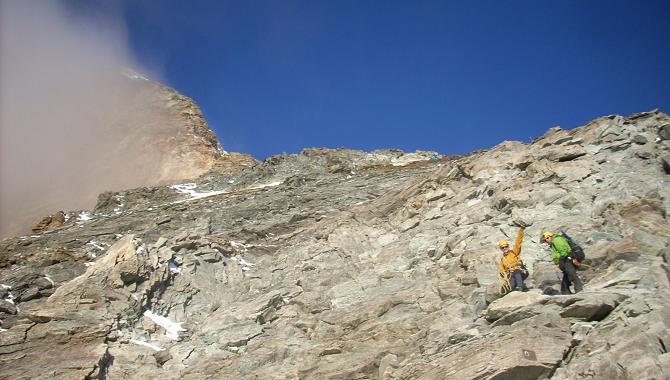 |
 |
| Summary
and postscript to the focus page |
 |
 |
 |
| This
page is constantly updated as a result of changing techniques,
conditions, and latest news. Please don't use this page
alone as the research you undertake for an ascent, and
it does definately not attempt to offer any of the instruction
of techniques which you will require. Details of many
other sources of information have been provided, which
you should consult before an ascent. Remember that to
climb Matterhorn is really a privilege, not a guarantee.
If you found this page of use, and have any other information
that others may find helpful, then please e-mail us. We
will post any useful extra information on the page, and
you will be cited. It is this sharing of knowledge that
makes the climbing community so close, and this extra
knowledge will increase your chances of summitting. |
|
 |
|



